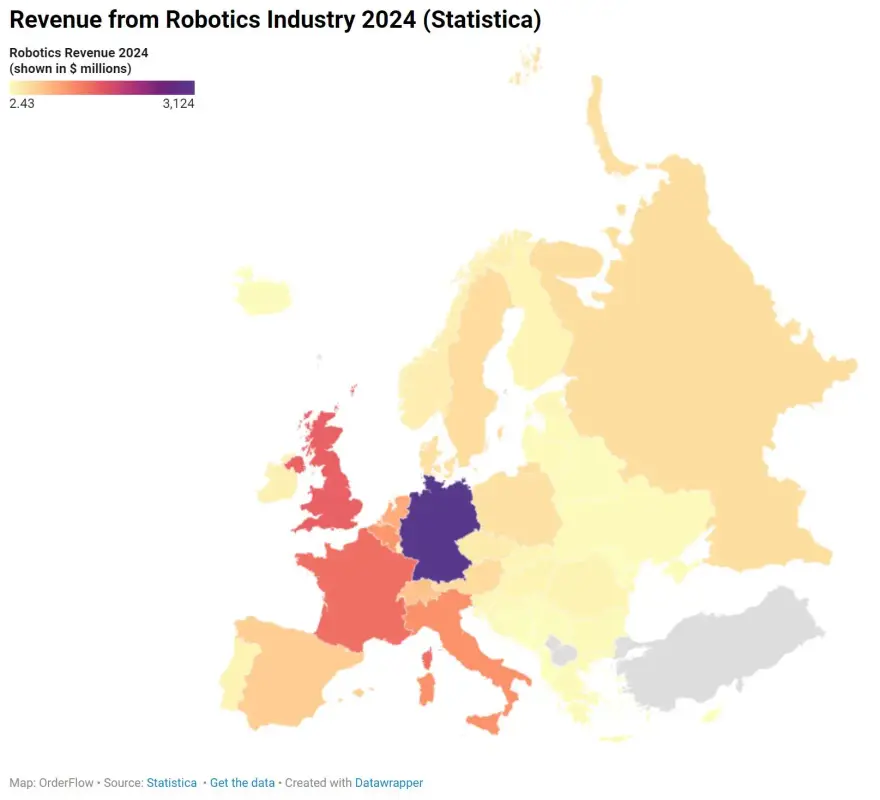The robotics industry has experienced a meteoric rise in recent years, reflected in both soaring Google search interest and substantial government funding on a global scale.
In 2024, Europe remains a global leader in robotics, with several countries significantly advancing in this field. Recent data from Statista, analyzed by OrderFlow, looks at the European countries that are investing the most in robotics compared to each other, their GDP and population.

The data shows that Germany is consistently leading the way in robotics revenue in 2016, 2024 and projected 2028, with a 33% increase in revenue making them a market leader within Europe.
Germany continues to dominate the European robotics landscape, boasting a robot density of 415 units per 10,000 employees.
This is a testament to its strong industrial base, particularly in the automotive and manufacturing sectors, which heavily rely on automation. Companies like Siemens and KUKA are pivotal in driving Germany’s leadership in robotics, contributing to its status as the third most automated country globally.
Sweden is another European country making significant strides in robotics. With 321 robots per 10,000 employees, it ranks high in Europe and globally. Sweden’s focus on integrating advanced technologies, including artificial intelligence and machine learning, into robotics has been a critical factor in its success. Educational institutions like the KTH Royal Institute of Technology play a crucial role in fostering innovation in this field.
Denmark is also emerging as a key player in robotics, particularly known for its expertise in collaborative robots (cobots).
With the warehouse industry starting to invest in robotic solutions within their warehouses, it would be beneficial to take a look to see how many of these countries are seeing an increase in revenue.
Which countries have seen a drop in robotics revenue?
Whilst by in large European nations have increased their robotics-attributed revenue over the previous 8 years some have seen a decrease as shown below:
| Country | Population | 2016 | 2024 | 2016 vs 2024 |
|---|---|---|---|---|
| Slovakia | 5,795,199 | 245.30 | 66.65 | -73% |
| Portugal | 10,247,605 | 165.80 | 113.00 | -32% |
| Luxembourg | 654,768 | 142.80 | 111.10 | -22% |
| Armenia | 2,777,970 | 2.42 | 1.89 | -22% |
| Czechia | 10,670,000 | 214.40 | 170.00 | -21% |
| Austria | 8,958,960 | 395.10 | 335.20 | -15% |
| Georgia | 3,728,282 | 3.53 | 3.09 | -12% |
| Sweden | 10,612,086 | 336.50 | 316.30 | -6% |
Germany’s success shows robotics are the way to go
Germany’s positive revenue result shows how much robotics can change the game in terms of speeding up processes and bringing in the most revenue. But how do robotics help the day to day processes in a warehouse environment?
Safety
Safety is one of the most important benefits. Robotics can take over some of the most risky and dangerous tasks, for example moving objects from a high up location, which brings the risks of falls from human error. Robots also may be able to work in environments that are hazardous to humans, (with the lifting of reducing the risk of human error and catastrophic incidents. A safer work environment will help businesses save money, and a safer work culture increases worker retention,
Reduce labour costs
Robots could be automated, reducing the need for human labour and associated salaries. The costs for robots might be more costly in the short term, however increased efficiency and accuracy will save time and be consistent every time. Warehouse robotics can assist with order fulfilment, stocktaking, customer services and picking for order fulfilment.
Improved inventory management is also beneficial with robotics. They can use RFID scanners and cameras for frequent and accurate inventory checks. Robotics update inventory systems in real time reducing the risk of error and enhancing decision making. As a result this leads to improved customer satisfaction through timely order fulfilment and optimal stock levels, reducing costs.
Improved Transportation
Robotics will use the likes of Automated Guided Vehicles (AGV’s) and Autonomous Mobile Robots (AMRs), which help to transport goods, reduce manual labour and minimise errors. If an issue comes up mid transportation, robotics are programmed to automatically adjust the route in real time.
How will Robotics impact warehouses in the future?
Germany and the UK’s success will no doubt lead more countries to take warehouse investment seriously, and with the UK coming in at second place will only drive more countries to try and catch up. Countries such as Belgium, Poland and Germany are set to grow their share over the next 4 years, so staying ahead of the technological curve is essential.
The majority of the revenue within robotics comes from Western Europe, however if the parameters to show relative increase in robotics-attributed revenue were to change, Eastern Europe countries such as Estonia and Latvia stand out massively in terms of countries that have increased their revenue coming in from the robotics industry.
Overall, it’s clear that robotic revenue is becoming a trend for warehouses, leading to day to day processes being completed at a faster pace that is safer for all working at the facility. Germany’s success is only going to fast forward advancement across Europe and the world.
OrderFlow specialise in a wide range of WMS solutions including 3pl warehouse management software and lot tracking. You can read more about their findings here.

